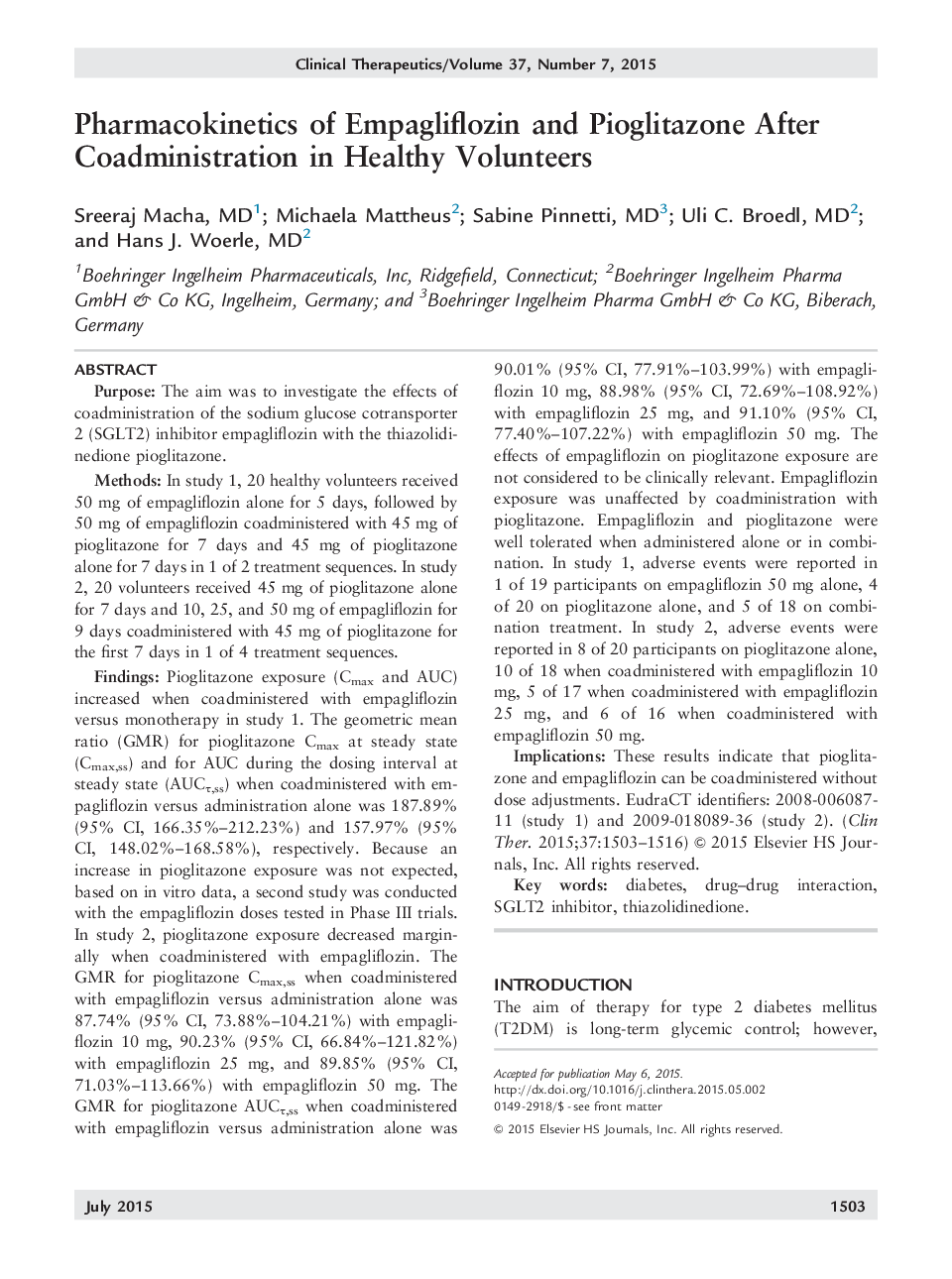| Article ID | Journal | Published Year | Pages | File Type |
|---|---|---|---|---|
| 5824762 | Clinical Therapeutics | 2015 | 14 Pages |
PurposeThe aim was to investigate the effects of coadministration of the sodium glucose cotransporter 2 (SGLT2) inhibitor empagliflozin with the thiazolidinedione pioglitazone.MethodsIn study 1, 20 healthy volunteers received 50 mg of empagliflozin alone for 5 days, followed by 50 mg of empagliflozin coadministered with 45 mg of pioglitazone for 7 days and 45 mg of pioglitazone alone for 7 days in 1 of 2 treatment sequences. In study 2, 20 volunteers received 45 mg of pioglitazone alone for 7 days and 10, 25, and 50 mg of empagliflozin for 9 days coadministered with 45 mg of pioglitazone for the first 7 days in 1 of 4 treatment sequences.FindingsPioglitazone exposure (Cmax and AUC) increased when coadministered with empagliflozin versus monotherapy in study 1. The geometric mean ratio (GMR) for pioglitazone Cmax at steady state (Cmax,ss) and for AUC during the dosing interval at steady state (AUCÏ,ss) when coadministered with empagliflozin versus administration alone was 187.89% (95% CI, 166.35%-212.23%) and 157.97% (95% CI, 148.02%-168.58%), respectively. Because an increase in pioglitazone exposure was not expected, based on in vitro data, a second study was conducted with the empagliflozin doses tested in Phase III trials. In study 2, pioglitazone exposure decreased marginally when coadministered with empagliflozin. The GMR for pioglitazone Cmax,ss when coadministered with empagliflozin versus administration alone was 87.74% (95% CI, 73.88%-104.21%) with empagliflozin 10 mg, 90.23% (95% CI, 66.84%-121.82%) with empagliflozin 25 mg, and 89.85% (95% CI, 71.03%-113.66%) with empagliflozin 50 mg. The GMR for pioglitazone AUCÏ,ss when coadministered with empagliflozin versus administration alone was 90.01% (95% CI, 77.91%-103.99%) with empagliflozin 10 mg, 88.98% (95% CI, 72.69%-108.92%) with empagliflozin 25 mg, and 91.10% (95% CI, 77.40%-107.22%) with empagliflozin 50 mg. The effects of empagliflozin on pioglitazone exposure are not considered to be clinically relevant. Empagliflozin exposure was unaffected by coadministration with pioglitazone. Empagliflozin and pioglitazone were well tolerated when administered alone or in combination. In study 1, adverse events were reported in 1 of 19 participants on empagliflozin 50 mg alone, 4 of 20 on pioglitazone alone, and 5 of 18 on combination treatment. In study 2, adverse events were reported in 8 of 20 participants on pioglitazone alone, 10 of 18 when coadministered with empagliflozin 10 mg, 5 of 17 when coadministered with empagliflozin 25 mg, and 6 of 16 when coadministered with empagliflozin 50 mg.ImplicationsThese results indicate that pioglitazone and empagliflozin can be coadministered without dose adjustments. EudraCT identifiers: 2008-006087-11 (study 1) and 2009-018089-36 (study 2).
